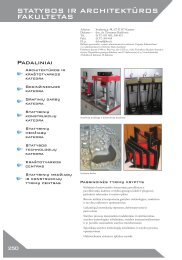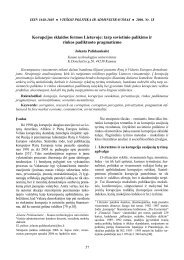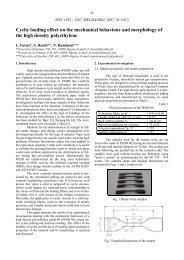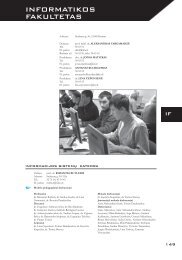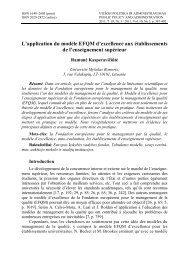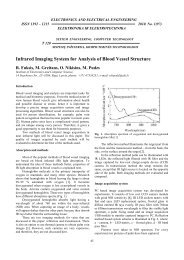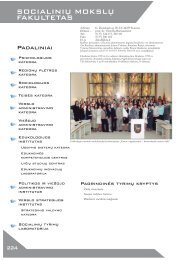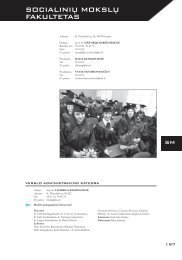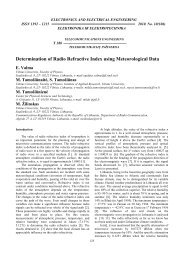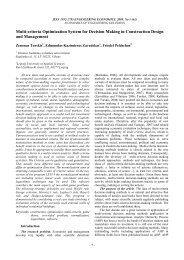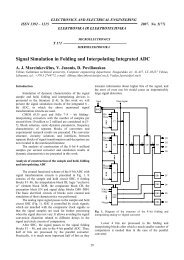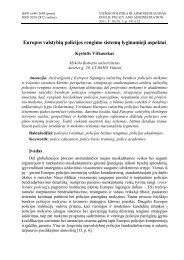The Study of Trace Elements in Bloomery Iron
The Study of Trace Elements in Bloomery Iron
The Study of Trace Elements in Bloomery Iron
You also want an ePaper? Increase the reach of your titles
YUMPU automatically turns print PDFs into web optimized ePapers that Google loves.
ISSN 1392–1320 MATERIALS SCIENCE (MEDŽIAGOTYRA). Vol. 16, No. 2. 2010<strong>The</strong> <strong>Study</strong> <strong>of</strong> <strong>Trace</strong> <strong>Elements</strong> <strong>in</strong> <strong>Bloomery</strong> <strong>Iron</strong>Jonas NAVASAITIS 1 , Aušra SELSKIENĖ 2 , G<strong>in</strong>tautas ŽALDARYS 1∗1Kaunas University <strong>of</strong> Technology, Kęstučio 27, LT-44312 Kaunas, Lithuania2Institute <strong>of</strong> Chemistry, A. Goštauto St. 9, LT-01108 Vilnius, LithuaniaReceived 29 June 2009; accepted 31 July 2009<strong>The</strong> present work is devoted to the study and characterization <strong>of</strong> compositional comparison <strong>of</strong> trace elements (Cu, Ni,Co, As) and m<strong>in</strong>or elements (P and S) <strong>in</strong> extracted iron, bog ore and smelt<strong>in</strong>g slag from various sites <strong>of</strong> Lithuania. <strong>The</strong>experimental bloomery smelt<strong>in</strong>g results are also discussed. <strong>Trace</strong> element data have been determ<strong>in</strong>ed us<strong>in</strong>g a scann<strong>in</strong>gelectron microscope EVO 50 EP with X-ray spectrometer <strong>of</strong> wave dispersion and a direct current plasma emissionspectrometer Beckman SpectraSpan VI. <strong>The</strong> results illustrate the potential <strong>of</strong> trace and m<strong>in</strong>or elements <strong>in</strong> the research <strong>in</strong>microstructure and mechanical properties <strong>of</strong> bloomery iron and <strong>in</strong> provenance studies <strong>of</strong> bloomery iron objects.Keywords: bloomery iron, bog ore, bloomery slag, trace elements, Lithuania.1. INTRODUCTION ∗Most trace elements get <strong>in</strong>to products <strong>of</strong> ironmetallurgy as lumps, iron artifacts and smelt<strong>in</strong>g slag fromore dur<strong>in</strong>g a smelt<strong>in</strong>g process. Technological processes,through which an ultimate result is obta<strong>in</strong>ed, also make an<strong>in</strong>fluence as some part <strong>of</strong> trace elements get <strong>in</strong>to ironarticles from ashes <strong>of</strong> fuel, flux and walls <strong>of</strong> iron smelt<strong>in</strong>gfurnaces.<strong>The</strong> most important trace elements <strong>in</strong> bloomery ironare nickel, copper, arsenic, cobalt and some others.Although the amount <strong>of</strong> trace elements <strong>in</strong> iron and steel isusually <strong>in</strong>significant, nevertheless they may have an efecton microstructure <strong>of</strong> a metal matrix and mechanicalcharacteristics. For example, enrichment with nickel<strong>in</strong>creases the stability <strong>of</strong> austenite, pearlite or other carbidedispersions, whereas arsenic <strong>in</strong>duces a ferrite form<strong>in</strong>gprocess [1]. <strong>The</strong>y also may help research <strong>in</strong>to iron artifactsprovenance as well as <strong>in</strong> technique <strong>of</strong> manufacture.Generally, iron produced from bog ore us<strong>in</strong>g the bloomerydirect smelt<strong>in</strong>g process is relatively pure, with an exception<strong>of</strong> entrapped slag <strong>in</strong>clusions, as temperature <strong>of</strong> thecarbothermal extraction <strong>in</strong> bloomery process does notexceed 1200 ºC – 1250 ºC and the extracted iron rema<strong>in</strong>s <strong>in</strong>solid state. <strong>The</strong> relatively pure sponge iron bloom formed<strong>in</strong> this way conta<strong>in</strong>s a large amount <strong>of</strong> smelt<strong>in</strong>g slag, whichhas to be removed by forg<strong>in</strong>g. Despite severe and sedulousforg<strong>in</strong>g a part <strong>of</strong> slag rema<strong>in</strong>s <strong>in</strong> the produced iron and itsproducts <strong>in</strong> the conformation <strong>of</strong> slag <strong>in</strong>clusions. <strong>The</strong>irchemical and phase compositions are presented <strong>in</strong> works[2 – 5] and others. Authors <strong>of</strong> these studies also show thepossible relations <strong>of</strong> the compositional characteristics <strong>of</strong>slag <strong>in</strong>clusions with both the smelt<strong>in</strong>g slag found <strong>in</strong> theiron production sites and the used ore. However,R. Gordon, with reference to the thorough researches <strong>in</strong>bloomery slag performed by S. Fells, ma<strong>in</strong>ta<strong>in</strong>s that it isdifficult to trace the sources <strong>of</strong> ore or get sufficient<strong>in</strong>formation about the type <strong>of</strong> an iron smelt<strong>in</strong>g furnace andsmelt<strong>in</strong>g technique us<strong>in</strong>g only the characteristics <strong>of</strong>smelt<strong>in</strong>g slag [6]. In the smelt<strong>in</strong>g process two phases –∗ Correspond<strong>in</strong>g author. Tel.: +370-37-300420; fax.: +370-37-323769.E-mail address: g<strong>in</strong>zald@ ktu.lt (G. Žaldarys)extracted iron and slag – are <strong>in</strong> a constant <strong>in</strong>teraction, andall ore components – major and m<strong>in</strong>or and the trac<strong>in</strong>g onesdistribute <strong>in</strong> these phases. <strong>The</strong>refore, analyses <strong>of</strong> traceelements are to be carried out <strong>in</strong> metal (iron) and slagphases, furthermore, it is relevant to compare the results <strong>of</strong>the analyses with the characteristics <strong>of</strong> ore components.One <strong>of</strong> the first studies <strong>of</strong> trace elements <strong>in</strong> bloomeryiron samples is presented <strong>in</strong> a work by E. Schurmann [7].Alongside the theoretical analysis <strong>of</strong> a direct ironextraction process, the author also presents the studyresults <strong>of</strong> trace elements (Cu, Ni, Cr, Al, Sn) and nonmetal<strong>in</strong>clusions <strong>in</strong> iron artifacts. Data <strong>of</strong> the further analysis <strong>of</strong>trace elements <strong>in</strong> bloomery iron and their distributionbetween metal matrix and slag <strong>in</strong>clusions are presented <strong>in</strong>works [2, 8 – 11]. R. F. Tylecote firstly accentuates suchelements as: carbon, phosphorus, sulphur, nickel andcopper as hav<strong>in</strong>g an importance to assess<strong>in</strong>g provenance <strong>of</strong>iron as well as to the technique <strong>of</strong> iron artifacts [12].<strong>Bloomery</strong> iron may have a different degree <strong>of</strong> carburization.Carbon gets <strong>in</strong>to iron from charcoal, however,avoid<strong>in</strong>g the homogeniz<strong>in</strong>g <strong>in</strong>fluence <strong>of</strong> a liquid phase, it isdistributed non uniformly <strong>in</strong> bloomery iron. Carburization<strong>of</strong> bloomery iron highly depends on conditions <strong>of</strong> smelt<strong>in</strong>g,thus, the amount <strong>of</strong> carbon is a significant <strong>in</strong>dicator <strong>of</strong> thesmelt<strong>in</strong>g process. <strong>The</strong> greater part <strong>of</strong> phosphorus comes <strong>in</strong>smelt<strong>in</strong>g products (iron and slag) from ore, while, some itsamount also comes from fuel ashes. For example, thecontent <strong>of</strong> P 2 O 5 <strong>in</strong> ashes <strong>of</strong> charcoal (ma<strong>in</strong> bloomery fuel)may vary from 4.2 wt.% to 16.7 wt.% [13]. Sulphur alsogets <strong>in</strong>to smelted iron and slag ma<strong>in</strong>ly from ore.Recently, studies <strong>of</strong> technique and provenance <strong>of</strong>artifacts manufactured <strong>of</strong> bloomery iron atta<strong>in</strong>ed seriousattention <strong>of</strong> researchers, but the <strong>in</strong>fluence <strong>of</strong> trace elementsis not properly revealed and data <strong>of</strong> their studies are sparseand basically connected with the samples <strong>of</strong> iron slag. InLithuania, there are also some works related to the studies<strong>of</strong> m<strong>in</strong>or and trace elements <strong>in</strong> bloomery iron, its productsand slag <strong>in</strong>clusions [14 – 19]. However, relation <strong>of</strong> thecharacteristics <strong>of</strong> ore composition (with regard to traceelements) to smelted iron, smelt<strong>in</strong>g slag and their<strong>in</strong>clusions <strong>in</strong> products has not been studied as yet at all.Such studies may give an important <strong>in</strong>formation to113
esearchers on tools, arms and other implements made <strong>of</strong>bloomery iron <strong>in</strong>vestigat<strong>in</strong>g peculiarities <strong>of</strong> microstructureand mechanical characteristics <strong>of</strong> products, theirmanufactur<strong>in</strong>g technique and provenance.<strong>The</strong> purpose <strong>of</strong> this paper is to present the results <strong>of</strong> astudy <strong>of</strong> some trace elements (Cu, Ni, Co, As) and m<strong>in</strong>orelements (P and S) <strong>of</strong> as-smelted bloomery iron samplesand <strong>of</strong> bog ore and smelt<strong>in</strong>g slag pieces from various sites<strong>of</strong> Lithuania. A compositional comparison <strong>of</strong> traceelements <strong>in</strong> bog ore, bloomery iron and smelt<strong>in</strong>g slagillustrates the importance <strong>of</strong> trace element data both <strong>in</strong>metallographic exam<strong>in</strong>ation and <strong>in</strong> provenance studies <strong>of</strong>early iron objects.2. SAMPLES AND TECHNIQUESIn Lithuania bloomery iron was produced from localbog ore composed <strong>of</strong> iron m<strong>in</strong>erals and gangue. Bog ore israther porous and highly heterogeneous material.<strong>Bloomery</strong> slag is also non-homogenous material consist<strong>in</strong>g<strong>of</strong> various phases. <strong>The</strong>refore, both bog ore and smelt<strong>in</strong>gslag were carefully ground <strong>in</strong> order to prepare exploratorysolutions for exam<strong>in</strong>ation. <strong>The</strong> elemental composition <strong>of</strong>ore and slag samples was determ<strong>in</strong>ed by optical emissionspectroscopy us<strong>in</strong>g a direct current plasma emissionspectrometer Beckman SpectraSpan VI.Several iron clots entrapped <strong>in</strong> smelt<strong>in</strong>g slag and someiron artifacts were chosen for the study <strong>of</strong> elementalcomposition and microstructure <strong>of</strong> produced metal.Elemental composition <strong>of</strong> polished and carbon coated ironsamples was exam<strong>in</strong>ed by a scann<strong>in</strong>g electron microscopeEVO 50 EP (Carl Zeiss SMT AG) with a wave dispersiveX-ray spectrometer (Oxford Instruments). Work<strong>in</strong>gconditions: acceleration voltage 20 kV and beam current40 nA. In each sample the element concentration wasmeasured <strong>in</strong> three (20 × 40) µm sites. Mean values <strong>of</strong> themeasurements are presented. Polished sections wereprepared for the metallographic study <strong>of</strong> iron clots andartifacts. Microstructure <strong>of</strong> the sections was exam<strong>in</strong>ed byoptical microscopes LMA-10 and Olympus BH2.3. RESULTS<strong>The</strong> bog ore samples were selected for exam<strong>in</strong>ationfrom seven sites <strong>of</strong> Lithuania and they were related tovarious periods <strong>of</strong> iron metallurgy. Direct iron productioncarried out for centuries required large resources <strong>of</strong> bogiron ore. Only <strong>in</strong> the medieval bloomery furnaces, theamount <strong>of</strong> used bog ore <strong>in</strong> Lithuania may run <strong>in</strong>to 250 –330 thousand tons [20]. Thus, the basic and best resources<strong>of</strong> bog ore were exhausted and nowadays very few oresources are found. For this reason currently excavated oreand ore samples from museums as well as archaeologicalf<strong>in</strong>ds <strong>of</strong> ore uncovered <strong>in</strong> iron smelt<strong>in</strong>g sites were used forthe exam<strong>in</strong>ations. <strong>The</strong>re were samples from VilkaviškisRegional Museum (present-day ore), Jurė village <strong>of</strong> KazlųRūda district (an ore sample <strong>of</strong> the 18 th – 19 th c.), Telšiai“Alka” Museum (present-day ore), Rūda village <strong>of</strong>Merk<strong>in</strong>ė district (an ore sample <strong>of</strong> the 17 th – 19 th c.),Kernavė ancient settlement <strong>in</strong> Širv<strong>in</strong>tos district (oresamples <strong>of</strong> the 10 th – 14 th c.), Lieporiai ancient settlement<strong>in</strong> Šiauliai city (ore samples <strong>of</strong> the 4 th – 6 th c.) and Janoniaiquarry <strong>of</strong> Anykščiai district (present-day ore). <strong>The</strong> oresamples conta<strong>in</strong>ed various amounts <strong>of</strong> iron rang<strong>in</strong>g from33.79 wt.% <strong>in</strong> the ore from Kernavė, to 57.8 wt.% <strong>in</strong> theore from Lieporiai. In addition to it silicon, alum<strong>in</strong>ium,phosphorus, calcium and other elements were found <strong>in</strong> theore m<strong>in</strong>erals.<strong>The</strong> analyses <strong>of</strong> chemical composition <strong>of</strong> the oresamples have revealed a negligible content <strong>of</strong> copper andnickel <strong>in</strong> the Lithuanian bog ore (Table 1). Averagecontent <strong>of</strong> copper is scarcely 0.004 wt.% and the largestcontent is found <strong>in</strong> the ore <strong>of</strong> Kernavė (0.007 wt.%).Average content <strong>of</strong> nickel amounted to 0.008 wt.% and thelargest content is found <strong>in</strong> the ore <strong>of</strong> Lieporiai ancientsettlement (0.029 wt.%). But slightly larger contents arefound <strong>of</strong> cobalt (av 0.037 wt.%) and arsenic (av0.017 wt.%). It is important to note that <strong>in</strong> the mostsamples <strong>of</strong> the Lithuanian bog ore there is a relatively largeamount <strong>of</strong> phosphorus. <strong>The</strong> lowest content <strong>of</strong> phosphorus(0.218 wt.%) is found <strong>in</strong> the ore <strong>of</strong> Kernavė and the largestone, reach<strong>in</strong>g even 2.11 wt.% – <strong>in</strong> the ore <strong>of</strong> Merk<strong>in</strong>ė. Anamount <strong>of</strong> sulphur <strong>in</strong> the exam<strong>in</strong>ed ore samples rangesfrom 0.004 wt.% to 0.106 wt.% and its average is0.091 wt.%. Besides, the samples <strong>of</strong> the ore conta<strong>in</strong> alsosome amount <strong>of</strong> chromium av 0.018 wt.% (limits0.011 wt.% – 0.023 wt.%), molybdenum av 0.003 wt.%(from 0 wt.% to 0.009 wt.%), strontium av 0.01 wt.%(from 0 wt.% to 0.019 wt.%), zirconium av 0.003 wt.%(limits 0.001 wt.% – 0.006 wt.%), plumbum av 0.003 wt.%(from 0 wt.% to 0.008 wt.%) and <strong>of</strong> t<strong>in</strong> av 0.001 wt.%(from 0 wt.% to 0.003 wt.%). <strong>The</strong> extraction <strong>of</strong> the latterelements is considerably harder, than that <strong>of</strong> iron anddur<strong>in</strong>g the bloomery smelt<strong>in</strong>g process they usually rema<strong>in</strong><strong>in</strong> the slag phase.<strong>Bloomery</strong> iron clots present <strong>in</strong> the lumps <strong>of</strong> smelt<strong>in</strong>gslag were another important object <strong>of</strong> the exam<strong>in</strong>ation.<strong>The</strong>y are formed <strong>of</strong> as-extracted iron therefore their studygives valuable <strong>in</strong>formation on the <strong>in</strong>itial elementalcomposition <strong>of</strong> the bloomery iron and its microstructure.Fig. 1. A microphoto <strong>of</strong> a section <strong>of</strong> iron clot embeded <strong>in</strong>bloomery slag, sample Nr. 04.15-1 from Lieporiai.Microstructure shows coars ferrite gra<strong>in</strong>s (white)surrounded by fayalite slag (variable gray). <strong>The</strong> sample isetched with natal (optical microscope, reflected light)114
Table 1. Analyses <strong>of</strong> trace elements <strong>in</strong> bog iron ores, iron clots, smelt<strong>in</strong>g slags and <strong>in</strong> some manufactured products, wt.%Bog iron ore(7 samples)<strong>Iron</strong> clots(7 samples)Smelt<strong>in</strong>g slag(3 samples)ProductsElementAverage Interval Average Interval Average IntervalBloomfromKernave,2 nd – 3 rd c. MetallicmatrixAxe fromLazd<strong>in</strong><strong>in</strong>kai, 10 th c.ForgeweldCu 0.004 0 – 0.007 0.026 0.011 – 0.050 0.005 0.002 – 0.008 n.d. tr. 0.025Ni 0.008 0.001 – 0.029 0.009 0 – 0.029 0.002 0.001 – 0.002 0.004 0.010 0.030Co 0.037 0.016 – 0.054 0.092 0.075 – 0.126 0.030 0.001 – 0.057 0.013 tr. 0.025As 0.017 0.003 – 0.042 0.115 0.005 – 0.165 0.024 0.001 – 0.047 0.063 0.120 1.640P 0.886 0.218 – 2.110 0.432 0.010 – 1.648 5.163 1.119 – 9.207 0.151 0.225 0.080S 0.091 0.004 – 0.106 0.005 0 – 0.010 0.026 0.001 – 0.052 0.003 0.020 n.d.Mn 0.400 0.200 – 0.574 0.019 0.006 – 0.051 0.446 0.412 – 0.481 n.d. tr. tr.n.d. – not detected; tr. – traces.Treatment <strong>of</strong> raw bloom results <strong>in</strong> drastic changes <strong>of</strong> assmeltediron. Particularly, smit<strong>in</strong>g procedures lead to theweld<strong>in</strong>g <strong>of</strong> iron particles, the expell<strong>in</strong>g <strong>of</strong> slag, thechang<strong>in</strong>g <strong>of</strong> an <strong>in</strong>itial microstructure <strong>of</strong> a bloom and evento some changes <strong>of</strong> elemental composition <strong>of</strong> metal. Inorder to avoid the <strong>in</strong>fluence <strong>of</strong> these processes, the ironclots present <strong>in</strong> smelt<strong>in</strong>g slag and not affected by anytreatment have been selected for exam<strong>in</strong>ation. However,they conta<strong>in</strong>ed plenty <strong>of</strong> slag. A microstructure section <strong>of</strong>iron clot present <strong>in</strong> smelt<strong>in</strong>g slag is shown <strong>in</strong> Fig. 1. <strong>The</strong>mass <strong>of</strong> iron clots ranges from several to some tens grams.<strong>The</strong> samples have been prepared from iron clots found <strong>in</strong>the fallow<strong>in</strong>g iron production sites: Jūrė <strong>of</strong> Kazlų Rūdadistrict (18 th – 19 th c.), Pučkornė (16 th – 17 th c.) andVaitakarčmis (16 th – 17 th c.), both <strong>of</strong> Varėna d., Lieporiai <strong>of</strong>Šiauliai city ( 4 th – 6 th c.), Paplienijis <strong>of</strong> Telšiai d. (3 rd – 5 thc.), Lazd<strong>in</strong><strong>in</strong>kai settlement <strong>of</strong> Kret<strong>in</strong>ga d., (about 2 nd c.)and Kereliai hill-fort <strong>of</strong> Kupiškis d. (2 nd – 3 rd c.).<strong>The</strong> analysis <strong>of</strong> the iron clots has revealed that theaverage contents <strong>of</strong> arsenic, cobalt and copper (0.115 wt.%As, 0.092 wt.% Co, 0.026 wt.% Cu) <strong>in</strong> the as-extractediron are much larger than <strong>in</strong> the ores, whereas the contents<strong>of</strong> sulphur (0.005 wt.%) and phosphorus (0.432 wt.%) <strong>in</strong>the clots are considerably less than <strong>in</strong> the ores. Only nickelis found <strong>in</strong> negligible quantities, <strong>in</strong> approximate equalamounts <strong>in</strong> ores and <strong>in</strong> the clots (Table 1).Slag formed by iron ore smelt<strong>in</strong>g <strong>in</strong> bloomery furnaceconsists ma<strong>in</strong>ly <strong>of</strong> compound fayalite (Fe 2 SiO 4 ) and <strong>of</strong> aglass phase formed <strong>of</strong> non-reduced gangue m<strong>in</strong>erals <strong>of</strong> ore,fuel (charcoal) ashes and other possible additions. Anexam<strong>in</strong>ation <strong>of</strong> the bloomery slags has shown that the glassphase occupies approximately 10 % – 15 % <strong>of</strong> the whole[21]. Usually bloomery slags conta<strong>in</strong> also some amount <strong>of</strong>wustite (FeO) and small contents <strong>of</strong> trace elementsdistributed among slag phases.<strong>The</strong> samples for the exam<strong>in</strong>ation <strong>of</strong> trace elements hadbeen prepared from the same lumps <strong>of</strong> slag that conta<strong>in</strong>ediron clots exam<strong>in</strong>ed <strong>in</strong> this work. <strong>The</strong>reby, it was ensuredthat for the analysis <strong>of</strong> slag and iron clots, the samples <strong>of</strong>the same smelt<strong>in</strong>g were used. As expected, the amounts <strong>of</strong>copper and nickel are very little (Table 1). A slightly largercontent <strong>of</strong> cobalt (av 0.03 wt.%) is found, and an averagecontent <strong>of</strong> phosphorus exceeds even 5 wt.% (limits1.119 wt.% – 9.207 wt. %).4. DISCUSSIONThis study was undertaken to reveal the content <strong>of</strong>trace elements (Cu, Ni, Co, As) and m<strong>in</strong>or elements (P andS) <strong>in</strong> bloomery iron produced <strong>in</strong> Lithuania. It is alsoimportant to know a compositional comparison <strong>of</strong> thoseelements <strong>in</strong> bog ore, <strong>in</strong> extracted iron and <strong>in</strong> smelt<strong>in</strong>g slag.An element way <strong>in</strong>to smelted iron depends on both oxidestability and smelt<strong>in</strong>g process parameters. Free energychanges <strong>of</strong> formation <strong>of</strong> oxides show that Cu, Ni, Co andAs could be reduced by carbon more easily than iron [22].<strong>The</strong> reduced element goes <strong>in</strong>to solution <strong>in</strong> the extractediron. Thus, the bloomery iron would commonly <strong>in</strong>volve thegreater part <strong>of</strong> trace elements (Cu, Ni, Co, As) available <strong>in</strong>iron ores. <strong>The</strong>refore, the concentration <strong>of</strong> trace elements <strong>in</strong>smelted iron is considerably higher than <strong>in</strong> the used ores.Besides, it should be noted that the amount <strong>of</strong> metalproduced <strong>in</strong> the bloomery smelt<strong>in</strong>g process amounts onlyto ca 16 % – 18 % <strong>of</strong> the weight <strong>of</strong> iron available <strong>in</strong> thesmelted ore [23]. <strong>The</strong> rest <strong>of</strong> trace elements stay <strong>in</strong>smelt<strong>in</strong>g slag. Compositional comparison <strong>of</strong> trace elementsfound <strong>in</strong> the Lithuanian bog ores, <strong>in</strong> extracted iron and <strong>in</strong>smelt<strong>in</strong>g slag is shown <strong>in</strong> Fig. 2.It is <strong>in</strong>terest<strong>in</strong>g to note that similar results werereceived <strong>in</strong> the experimental direct iron smelt<strong>in</strong>g. In 2004the authors <strong>of</strong> the study carried out an experimental ironsmelt<strong>in</strong>g under outdoor conditions <strong>in</strong> a bloomery furnace.For the smelt<strong>in</strong>g, the local bog ore excavated <strong>in</strong> the fields<strong>of</strong> Žiūriai–Gudeliai village (Vilkaviškis district) was used.After the procedures <strong>of</strong> sluic<strong>in</strong>g and burn<strong>in</strong>g the oreconta<strong>in</strong>ed ca 75 wt.% – 76 wt.% Fe 2 O 3 (ca 52.4 wt.% –53.5 wt.% Fe) and ca 13 wt.% – 15 wt.% SiO 2 . <strong>The</strong> content<strong>of</strong> other additions amounted to ca 8 wt.% – 10 wt.%. In thesmelt<strong>in</strong>g process charcoal <strong>of</strong> deciduous trees was used, not115
Table 2. Chemical analyses <strong>of</strong> ore, iron clots and slag from the experimental smelt<strong>in</strong>g, wt %ElementBog iron ore <strong>Iron</strong> clots Smelt<strong>in</strong>g slagAverage Interval Average Interval Average IntervalCu 0.006 0.014 tr.Ni 0.003 0.017 0.005 tr. – 0.010Co 0.105 0.100 – 0.110 0.211 0.200 – 0.217 0.078 0.075 – 0.081As 0.023 0.021 – 0.024 0.234 0.212 – 0.243 n.d.P 1.381 1.292 – 1.470 3.606 2.739 – 4.372 1.688 1.458 – 1.866S 0.066 0.058 – 0.078 0.010 0.002 – 0.016 0.015 0.013 – 0.018Mn 0.723 0.443 – 1.422 n.d. 2.115 1.883 – 2.407Zn 0.010 0.008 – 0.011 n.d. 0.005 0.002 – 0.008Cr 0.006 0.005 – 0.007 0.003 0.012 0.009 – 0.014Mo 0.004 tr. – 0.007 0.002 tr.V 0.010 0.004 – 0.016 n.d. 0.012 0.007 – 0.018n.d. – not detected; tr. – traces.Content, wt %0.120.080.0400.004Ore Metal Slag0.005 0.0080.0370.0920.030.1150.026 0.0240.0090.0020.017Cu Ni Co AsFig. 2. Compositional comparison <strong>of</strong> Cu, Ni, Co and As <strong>in</strong> bogiron ores, extracted iron and <strong>in</strong> smelt<strong>in</strong>g slagsflux materials. <strong>The</strong> experimental smelt<strong>in</strong>g resulted <strong>in</strong> aniron-rich slag with dispersed pieces <strong>of</strong> the extracted ironimbedded <strong>in</strong> the slag. <strong>The</strong> iron clots had various content <strong>of</strong>carbon from ca 0.01 % wt.% C (low carbon ferrite) up tothe cast iron level. <strong>The</strong> total weight <strong>of</strong> reduced ironamounted to ca 0.23 kg. Although the yield was ratherpoor, but iron was produced as a result <strong>of</strong> experimentalbloomery smelt<strong>in</strong>g. <strong>The</strong> results <strong>of</strong> chemical analyses <strong>of</strong>ore, iron clots and slag from the experimental smelt<strong>in</strong>g aregiven <strong>in</strong> Table 2. Compositional comparison <strong>of</strong> traceelements <strong>in</strong> bog ore, extracted iron and slag from theexperimental smelt<strong>in</strong>g is shown <strong>in</strong> Fig. 3.<strong>The</strong> analyses <strong>of</strong> elemental composition have revealedthe negligible content <strong>of</strong> copper and nickel <strong>in</strong> both theLithuanian bog ores and extracted iron. Atomic radii <strong>of</strong>copper and nickel are relatively similar to that <strong>of</strong> iron;therefore, they easily go <strong>in</strong>to substitutional solid solutions<strong>in</strong> the austenite or ferrite lattice. Inord<strong>in</strong>ately little amount<strong>of</strong> these elements <strong>in</strong> iron does not have any marked<strong>in</strong>fluence on the metal microstructure or its mechanicalcharacteristics. However, <strong>in</strong> the forge welds segregation <strong>of</strong>Content, wt. %0.240.160.080Ore Metal Slag0.014 0.0170.006 0.003 0.0050.1050.2110.0780.2340.023Cu Ni Co AsFig. 3. Experimental smelt<strong>in</strong>g. Compositional comparison <strong>of</strong> Cu,Ni, Co and As <strong>in</strong> bog iron ore, extracted iron and <strong>in</strong>smelt<strong>in</strong>g slagcopper and nickel has been found (Table 1). <strong>The</strong> exam<strong>in</strong>ediron clots also demonstrate the negligible amount <strong>of</strong>sulphur, while bog ore samples conta<strong>in</strong> a notable level <strong>of</strong>this element. Presumably, the greater part <strong>of</strong> sulphur hasbeen burnt out dur<strong>in</strong>g the smelt<strong>in</strong>g process and the rest <strong>of</strong> ithas stayed <strong>in</strong> slag.<strong>The</strong> overall content <strong>of</strong> cobalt <strong>in</strong> exam<strong>in</strong>ed iron variesfrom 0.075 wt.% to 0.126 wt.% (av 0.092 wt.%). Cobalthas a high solubility <strong>in</strong> α- and γ-iron but a weak ferritestrengthen<strong>in</strong>g tendency. An alloy<strong>in</strong>g effect on ferritehardness beg<strong>in</strong>s only from about 0.5 % – 1 % <strong>of</strong> cobaltcontent <strong>in</strong> iron. Thus, much larger amounts (5 % to 20 %Co) are employed <strong>in</strong> modern high-alloy steels [24].Consequently, cobalt content found <strong>in</strong> the studied clots istoo low to have an <strong>in</strong>fluence on the mechanical properties<strong>of</strong> iron. However, it can be an important factor <strong>in</strong>provenance studies <strong>of</strong> bloomery iron artifacts.Arsenic and phosphorus, <strong>in</strong> particular, are present atsignificant levels (av 0.115 wt.% As and 0.432 wt.% P) <strong>in</strong>the exam<strong>in</strong>ed iron clots. Arsenic is not volatile underbloomery smelt<strong>in</strong>g conditions, therefore, its greater part116
available <strong>in</strong> ore enters the extracted iron. But a good deal<strong>of</strong> phosphorus goes <strong>in</strong>to the slag. R. F. Tylecote suggeststhat the ratio <strong>of</strong> phosphorus <strong>in</strong> the slag to that <strong>in</strong> the metaldepends on both the phosphorus content <strong>in</strong> ore and theparameters <strong>of</strong> smelt<strong>in</strong>g process [13]. Both arsenic andphosphorus have limited solid solubility <strong>in</strong> ferrite andstabilize it. Presence <strong>of</strong> carbon reduces the solubility <strong>of</strong>arsenic <strong>in</strong> iron. J. Piaskowski asserts that there exists an<strong>in</strong>verse correlation between the amounts <strong>of</strong> arsenic andcarbon <strong>in</strong> iron [25]. Arsenic distribution <strong>in</strong> ferrite andpearlite matrix <strong>in</strong> the iron clot from Kereliai is presented <strong>in</strong>Fig. 4. It has been found that phosphorus and arsenicdemonstrate a high segregation <strong>in</strong> iron, thus result<strong>in</strong>g <strong>in</strong> aformation <strong>of</strong> banded structure <strong>in</strong> forged and rolled ironartefacts [1, 9, 13, 25, 26].Fig. 4. Kerelian iron clot Nr. 03.15-1. SEM, back scatteredelectron image with As K α l<strong>in</strong>e scan. Arsenic contentvaries from 0.19 wt.% <strong>in</strong> pearlite up to 0.37 wt.% <strong>in</strong>ferrite<strong>The</strong> ratio <strong>of</strong> phosphorus content <strong>in</strong> exam<strong>in</strong>ed ironclots, ores and slags demonstrates that smelters werecapable <strong>of</strong> produc<strong>in</strong>g rather good iron from ores conta<strong>in</strong><strong>in</strong>gcomparatively a high amount <strong>of</strong> phosphorus. Dur<strong>in</strong>g theexperimental smelt<strong>in</strong>g the follow<strong>in</strong>g result has not beenobta<strong>in</strong>ed. <strong>The</strong> reason could be a lack <strong>of</strong> flux materials <strong>in</strong>the charge and comparatively high (over 1300 °C)temperature <strong>of</strong> the smelt<strong>in</strong>g process.In general, phosphorus and arsenic are detrimentalimpurities <strong>in</strong> iron. On the other hand, some amounts <strong>of</strong> Asand P (due to the solid solutions <strong>in</strong> iron) help <strong>in</strong>crease thestrength and hardness <strong>of</strong> the low-carbon iron. F<strong>in</strong>ally,phosphorus and arsenic, <strong>in</strong> particular, may assist <strong>in</strong> anidentification <strong>of</strong> provenance <strong>of</strong> iron artifacts.5. CONCLUSIONS1. Analyses <strong>of</strong> elemental composition <strong>of</strong> the ore sampleshave revealed negligible content <strong>of</strong> copper and nickel<strong>in</strong> the Lithuanian bog iron ores. Average content <strong>of</strong> Cuis scarcely 0.004 wt.% and that <strong>of</strong> Ni amounts to0.008 wt.%. Rather larger contents <strong>of</strong> cobalt (av0.037 wt.%) and arsenic (av 0.017 wt.%) have beenfound there. It is important to note that <strong>in</strong> the mostsamples <strong>of</strong> the Lithuanian bog iron ore there is arelatively large amount <strong>of</strong> phosphorus reach<strong>in</strong>g <strong>in</strong> someores studied even more than 2 wt.% (the ore fromMerk<strong>in</strong>ė). Besides, <strong>in</strong> the ore samples there were als<strong>of</strong>ound small quantities <strong>of</strong> S, Cr, Zn, Mo, Sr, Zr, Pb andSn.2. In the bloomery smelt<strong>in</strong>g process copper, nickel, cobaltand arsenic reduced from their oxides go <strong>in</strong>to thesolution <strong>in</strong> extracted iron. Thus, the results <strong>of</strong> theelemental analyses <strong>of</strong> the Lithuanian raw bloomery iron(iron clots entrapped <strong>in</strong> smelt<strong>in</strong>g slag) show that theaverage amounts <strong>of</strong> arsenic, cobalt and copper(0.115 wt.% As, 0.092 wt.% Co, 0.026 wt.% Cu) <strong>in</strong> asextractediron are much larger than <strong>in</strong> the ores, whereasthe contents <strong>of</strong> sulphur (0.005 wt.%) and phosphorus(0.432 wt.%) <strong>in</strong> the clots are considerably lower than <strong>in</strong>the ores. Only negligible amounts <strong>of</strong> nickel have beenfound <strong>in</strong> iron clots. Certa<strong>in</strong> segregation <strong>of</strong> traceelements <strong>in</strong> a metallic matrix and forge welds <strong>of</strong> theexam<strong>in</strong>ed artifacts are also observed.3. <strong>The</strong> amount <strong>of</strong> trace elements (Cu, Ni, Co and As) <strong>in</strong>bloomery slags is much lower than that <strong>in</strong> the exam<strong>in</strong>ediron clots. And higher concentrations <strong>of</strong> sulphur(0.026 wt.%) and phosphorus (5.163 wt.%) <strong>in</strong> slagdemonstrate that the optimum smelt<strong>in</strong>g parameters help<strong>in</strong> reduction <strong>of</strong> sulphur and phosphorus contents <strong>in</strong>bloomery iron.REFERENCES1. Charles, J.A. Development and Use <strong>of</strong> Layered FerrousMicrostructure Materials Science and Technology 141998: pp. 496 – 503.2. Hedges, R. E. M., Salter, C. J. Source Determ<strong>in</strong>ation <strong>of</strong><strong>Iron</strong> Currency Bars through Analysis <strong>of</strong> the Slag InclusionsArchaeometry 21 (2) 1979: pp. 161 – 175.3. Buchwald, V. F., Wivel,H. Slag Analysis as a Method forthe Characterization and Provenanc<strong>in</strong>g <strong>of</strong> Ancient <strong>Iron</strong>Objects Materials Characterization 40 1998. New York,Elsevier Science Inc., 1998: pp. 73 – 96.4. Høst-Madsen, L., Buchwald, V. F. <strong>The</strong> Characterizationand Provenanc<strong>in</strong>g <strong>of</strong> Ore, Slag and <strong>Iron</strong> from the <strong>Iron</strong> AgeSettlement at Snorup Historical Metallurgy 33 (2) 1999:pp. 57 – 67.5. Paynter, S. Regional Variations <strong>in</strong> <strong>Bloomery</strong> Smelt<strong>in</strong>g Slag<strong>of</strong> the <strong>Iron</strong> Age and Romano – British PeriodsArchaeometry 48 (2) 2006: pp. 271 – 292.6. Gordon, R. B. Process Deduced from <strong>Iron</strong>mak<strong>in</strong>g Wastesand Artefacts Journal <strong>of</strong> Archaeological Science 241997: pp. 9 – 18.7. Schürmann, E. Die Reduktion des Eisens im RennfeuerStahl und Eisen 78 (9) 1958: pp. 1297 – 1308 (<strong>in</strong> German).8. Mazur, W., Nosek, E. Investigation <strong>of</strong> the Hoard <strong>of</strong>currency bars from Kraków Archaeometallurgy <strong>of</strong> <strong>Iron</strong>,Internacional Symposium Liblice, 5 – 9 October 1987ed. R. Ple<strong>in</strong>er Prague, 1989: pp. 429 – 435, plates XXVI –XXIX.9. Scott, B. G. Early Irish <strong>Iron</strong>work<strong>in</strong>g. Belfast, UlsterMuseum, 1990.10. Joosten, I., van Nie, M. An Outl<strong>in</strong>e <strong>of</strong> Early <strong>Iron</strong>Production <strong>in</strong> the Netherlands La s<strong>in</strong>derurgie ancienne del’Est de la France dans son contexte europeen, Colloque deBesançon; 10 – 13 Novembre 1993 ed. M. Mang<strong>in</strong>Besançon, 1994: pp. 275 – 284.11. Coustures, M. P., Beźiat, D., Tallon, F. et al. <strong>The</strong> Use <strong>of</strong><strong>Trace</strong> Element Analysis <strong>of</strong> Entrapped Slag Inclusions to117
Establish Ore – Bar <strong>Iron</strong> L<strong>in</strong>ks: Examples from Two Gallo –Roman <strong>Iron</strong>-mak<strong>in</strong>g Sites <strong>in</strong> France Archaeometry 45 (4)2003: pp. 599 – 613.12. Tylecote, R. F. A History <strong>of</strong> Metallurgy. London. <strong>The</strong>Metals Society, 1976.13. Tylecote, R. F. Metallurgy <strong>in</strong> Archaeology. London,Edward Arnold Ltd, 1962: p. 348.14. Stankus, J. <strong>The</strong> Technology <strong>of</strong> <strong>Iron</strong> Artefacts from theCastle <strong>of</strong> Vilnius Early <strong>Iron</strong> Production – Archaeology,Technology and Experiments, Nordic <strong>Iron</strong> Sem<strong>in</strong>ar, Lejre,22 – 28 July, 1996 ed. L. Chr. Nørbach Technical report 3,Lejre, 1997: pp. 133 – 141.15. Michelbertas, M., Petravičius, A. Analyses <strong>of</strong> ChemicalComposition <strong>of</strong> Metallic Artefacts <strong>of</strong> the Roman PeriodKultūros paveldas-97 ed. V. Brimienė, Vilnius 1997:pp. 3 – 9 (<strong>in</strong> Lithuanian).16. Navasaitis, J., Pilkaitė, T., Sveikauskaitė, A., Matulionis,E. A <strong>Study</strong> <strong>of</strong> Forge Welds <strong>in</strong> Wrought <strong>Iron</strong> MaterialsScience (Medžiagotyra) 2 1999: pp. 50 – 53.17. Navasaitis, J., Sveikauskaitė, A., Matulionis, E.,Kurt<strong>in</strong>aitienė, M. Composition <strong>of</strong> Slag Inclusions <strong>in</strong><strong>Bloomery</strong> <strong>Iron</strong> Objects Acta Metallurgica Slovaca 72001: pp. 41 – 50.18. Navasaitis, J. <strong>Trace</strong>s <strong>of</strong> Slag-pit Furnaces <strong>in</strong> LithuaniaArchaeometallurgy <strong>in</strong> Europe, v.1, International Conference24 – 26 September, 2003, Associazione Italiana DiMetallurgia, Milan, 2003: pp. 517 – 523.19. Navasaitis, J., Selskienė, A. Metallographic Exam<strong>in</strong>ation <strong>of</strong>Cast <strong>Iron</strong> Lump Produced <strong>in</strong> the <strong>Bloomery</strong> <strong>Iron</strong> Mak<strong>in</strong>gProcess Materials Science (Medžiagotyra) 13 (2) 2007:pp. 167 – 173.20. Navasaitis, J. Lithuanian <strong>Iron</strong>. Kaunas, Technologija, 2003:p. 131 (<strong>in</strong> Lithuanian).21. Morton, G. R., W<strong>in</strong>grtove, J. Constitution <strong>of</strong> <strong>Bloomery</strong>Slags: Part I: Roman Journal <strong>of</strong> the <strong>Iron</strong> and Steel InstituteDecember 1969: pp. 1556 – 1564.22. Swal<strong>in</strong>, R. A. <strong>The</strong>rmodynamics <strong>of</strong> Solids. New York, JohnWiley & Sons, Inc, 1964: p.84.23. Radwan, M. Ores, Forges and <strong>Iron</strong> Blast – Furnaces <strong>in</strong>Poland. Warszawa, Wyd. Naukowo-Techniczne, 1963(<strong>in</strong> Polish).24. Bullens, D. K. Metallurgical Staff <strong>of</strong> the BMI Steel and ltsHeat Treatment, v. III. New York – London, John Wiley andsons, Inc, 1963: p. 79.25. Piaskowski, J. Das Vorkommen von Arsen <strong>in</strong> antiken undfrühmittelalterlichen Gegenständen aus RenneisenZeitschtrift fuer Archäologie 18, Berl<strong>in</strong>, 1984: pp. 213 – 226(<strong>in</strong> German).26. Tylecote, R. F., Thomsen, R. <strong>The</strong> Segregation and Surface-Enrichment <strong>of</strong> Arsenic and Phosphorus <strong>in</strong> Early <strong>Iron</strong>Artefacts Archaeometry 15 (2) 1973: pp. 193 – 198.118



